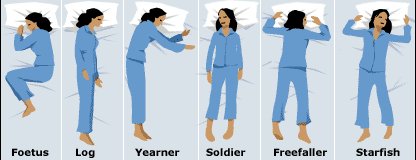
In junior high, I found a library book on sleep positions that fascinated me. I can't remember the title, and an internet search on the subject found few leads except SIDS research and positions of the karma sutra. Maybe the "night language of the body" is a dying art.
The non-verbal communication we dispense during waking hours can be a powerful road map to our personalities, our beliefs, our dreams. Even during waking hours, subconscious behavior is filtered through the lens of our experiences. So what happens when the awareness of our own bodies slips away in sleep? Can the sleep position our bodies gravitate to be as telling as words spoken during the dream state?
Professor Chris Idzikowski, director of the Sleep Assessment and Advisory Service began an analysis of sleep positions while studying five distinctive types of snoring. His research focuses on the six most common sleep positions and the links to particular personality types.
The positions: The Foetus: Also known as the fetal position. Forty-one percent of those studied and twice as many women as men fit into this category. This position belongs to individuals who can appear tough on the outside, but have a "big heart" on the inside. Recharging that soft, vulnerable part of themselves during sleep is essential.
The Foetus: Also known as the fetal position. Forty-one percent of those studied and twice as many women as men fit into this category. This position belongs to individuals who can appear tough on the outside, but have a "big heart" on the inside. Recharging that soft, vulnerable part of themselves during sleep is essential.
The Log: Fifteen percent of sleepers researched slept in this position, characterized by lying on their side, both arms down close to the body. These people are social creatures who often trust strangers, sometimes to the point of being gullible.
The Yearner: Participants who slept on their side with both arms out, around 13 percent, possessed an open, but often cynical or suspicious nature. They may require time to reach decisions, but once made won't change their mind.
The Soldier: Only 8 percent of sleep subjects slept on their back with both arms resting close to the body. Often quiet and reserved people, they avoid loud discussions. They set high standards for themselves and those around them.
The Freefall: In 7 percent of the cases, subjects slept on their stomach, arms wrapped around the pillow, head turned to the side. These people are sociable, but can be interpreted as abrasive or bad-tempered, often rejecting criticism.
The Starfish: Five percent of participants slept on their back with both arms up around the pillow. Trustworthy and good listeners, they dislike being the center of attention.
I want to add my own unscientific category here, namely because my sleep position isn't represented in the above and it's the main reason that jr. high book stuck in my brain:
The Flamingo: A combination of the log and fetal position. One straight leg represents the part of the personality seen by the world; the curled leg is symbolic of the closely guarded, private side few will ever see.
Completely me.
The remaining 5 percent of study participants slept with such variation, they couldn't be matched into any one category.
If you're into the ultra-scientific Cosmo version, you can zoom in on it here along with a lacy boy-shorts model demonstration instead of a cartoonish Wal-mart jammies version.
How accurate is Idzikowski's study? Did you find yourself? Does anyone really want to own the freefall one? Ouch.
I've gone from foetus to soldier in recent years. I don't even want to analyze that as to what that means about me!
Unfortunately, my sleep position is based on two major things: whether or not my husband is in the bed with me, and what's most comfortable...
But very interesting none-the-less, L.A.
Jen
What do you call yourself if your sleep positions vary wildly and are constantly shifting? "The Indecisive"? I'm at least 4 of these every night... 🙂
This comment has been removed by a blog administrator.
This comment has been removed by a blog administrator.